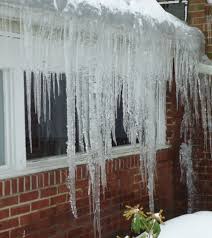If you live in a climate that includes cold winters, you know the season creates special challenges for homeowners. In this article, we discuss an icy situation.
Ice Dams
An ice dam refers to ice that has formed along a roof’s edge. The dam of ice blocks additional water and the pooling water backs up and finds pathways into a home’s interior. This water may cause deterioration and decay to interior wood and plaster, drywall or other insulation materials. Once an ice dam has forced paths into a home, the roof becomes more susceptible to future ice dams and water damage.
Too much heat rising from the home to warm the roof is the most frequent cause of ice dams. The process occurs unevenly with the warmer area at the higher part of the roof melting the snow and then the cooler, lower area, particularly the roof edge, permitting the water to refreeze and then accumulate. Inadequate insulation lets too much heat escape into the attic and this creates a warmer roof. Improper ventilation creates moisture and heat buildup due to the lack of air movement.
How To Detect A Problem
Compare the way the snow is melting from the living area of your home with how snow appears on the roof over an unheated area such as a garage or shed. How does any snow coverage on your roof compare with your neighbors’ homes? Check for icicles. They can be pretty, but heavy icicle buildup means that interior heat is melting a lot of snow and may contribute to ice dams.
How To Prevent Ice Dams
There are a number of ways to help prevent ice dams:
- Clear excess snow from the roof. However, in order to minimize damage to the roof and roofing, hire a professional to remove the snow.
- Add rubberized or special roofing adhesives to help prevent pooled water on the roof from finding entry into the home’s interior.
- Inspect the attic and roof for cracks, holes, or joints that permit warm air to escape to the roof, and seal or repair these areas.
- Add the recommended amount of insulation to the attic and exterior walls of your home to minimize escaping heat (this also reduces your heating costs).
- Reduce your home’s thermostat and throw on warmer clothing during extended cold spells.
- Clear your gutters and downspouts so that water is properly shed off your roof.
As always, an insurance professional is a valuable source of safety and insurance information. Don’t hesitate to contact an agent to discuss your questions. If you haven’t had the chance, please be sure to read parts two and three of “Is Your Home Winter Ready” which discusses other winter concerns.
Continue to Section 2
COPYRIGHT: Insurance Publishing Plus, Inc. 2017 All rights reserved. Production or distribution, whether in whole or in part, in any form of media or language; and no matter what country, state or territory, is expressly forbidden without written consent of Insurance Publishing Plus, Inc.I

 Contact
Contact
 Email an Agent
Email an Agent

 Click to Call
Click to Call Get Directions
Get Directions


